As an Amazon Associate KitchenwareSets.com earns from qualifying purchases.
Traditional Japanese Kitchen Secrets for a Calming Space
Is your kitchen a source of stress? For many of us, the heart of the home is a chaotic space filled with overflowing drawers, cluttered countertops, and a constant sense of visual noise. It’s the last place you’d go to feel calm and centered. This daily friction not only makes cooking a chore but can seep into the rest of your life, creating a subtle but persistent feeling of disarray. You deserve a space that nurtures your spirit, not just your body.
What if your kitchen could be a sanctuary? A place of serene simplicity, where every object has a purpose and the very atmosphere encourages mindfulness. This isn’t a far-off dream; it’s the core principle of a traditional Japanese kitchen. It’s a design philosophy that transforms the simple act of preparing food into a peaceful, grounding ritual. By embracing time-honored secrets, you can create a kitchen that calms your soul instead of cluttering your mind.
The traditional Japanese kitchen philosophy centers on harmony, simplicity, and natural materials. It creates a calming, functional space by eliminating clutter, embracing a muted color palette, and fostering a deep connection to the natural world in its design and decor. We’ve distilled centuries of Japanese design principles and modern interpretations into a clear, actionable guide to help you transform your space.
Craving a Kitchen That Calms Your Soul, Not Clutters Your Mind?
A traditional Japanese kitchen philosophy offers a profound solution by centering on harmony, simplicity, and a deep respect for nature. This approach isn’t just about aesthetics; it’s about creating a functional, calming space that works with you. By strategically eliminating clutter, embracing a muted and earthy color palette, and fostering a seamless connection to the natural world, this design style transforms the kitchen from a place of chaotic energy into a sanctuary of peace.
The beauty of this philosophy is its ability to create an environment that feels both purposeful and tranquil. Every element, from the choice of wood to the placement of a teacup, is considered. It’s a mindful approach to design that has influenced global trends for a reason—it works. We’ve distilled these centuries-old principles into a clear, actionable guide to help you bring this sense of calm into your own home.
The Foundation: Blending Tradition with Modern Minimalist Trends
The modern interpretation of the traditional Japanese kitchen is rooted in a blend of core philosophies like Minimalism, Japandi, and Wabi-Sabi. Understanding these concepts allows you to make more intentional design choices that go beyond simply copying a look; it helps you create a space with genuine soul and tranquility. By grasping these foundational ideas, you’ll be equipped to apply the specific secrets that follow in a way that feels authentic to you and your home.
- Minimalism: At its heart, this is the principle of “less is more.” It means creating a spacious, uncluttered environment where every single item has a clear purpose and place. Visual noise is actively eliminated to foster a sense of freedom and calm.
- Japandi: This is a beautiful and popular design hybrid that blends Japanese minimalism with Scandinavian functionality. It creates calm, restrained, and inviting spaces by emphasizing natural materials, clean lines, purposeful layouts, and a soft, neutral color palette of whites, beige, and light woods.
- Wabi-Sabi: This is the ancient Japanese art of finding beauty in imperfection, asymmetry, and the natural process of aging. A Wabi-Sabi kitchen celebrates raw, tactile materials like rough-sawn wood, stone with visible marks, and ceramics with uneven glazes, honoring the history and unique character of each object.
7 Secrets to Designing a Traditional Japanese Kitchen That Breathes Tranquility
To truly create a Zen-like kitchen, you need to go beyond surface-level aesthetics and embrace the core principles that give this design its soul. These curated secrets are based on timeless Japanese traditions, thoughtfully adapted for the modern home to ensure you achieve a perfect balance of beauty, functionality, and tranquility. This is your step-by-step guide to transforming your kitchen into a peaceful and highly functional space that breathes serenity into your daily life. The key lies in these seven areas:
- Embrace Simplicity & Minimalism
- Prioritize Natural Materials
- Use a Muted & Earthy Color Palette
- Foster a Connection to Nature
- Illuminate with Soft, Ambient Lighting
- Decorate with Purposeful Restraint
- Celebrate Craftsmanship & Imperfection
1. Embrace Simplicity with Unseen Storage
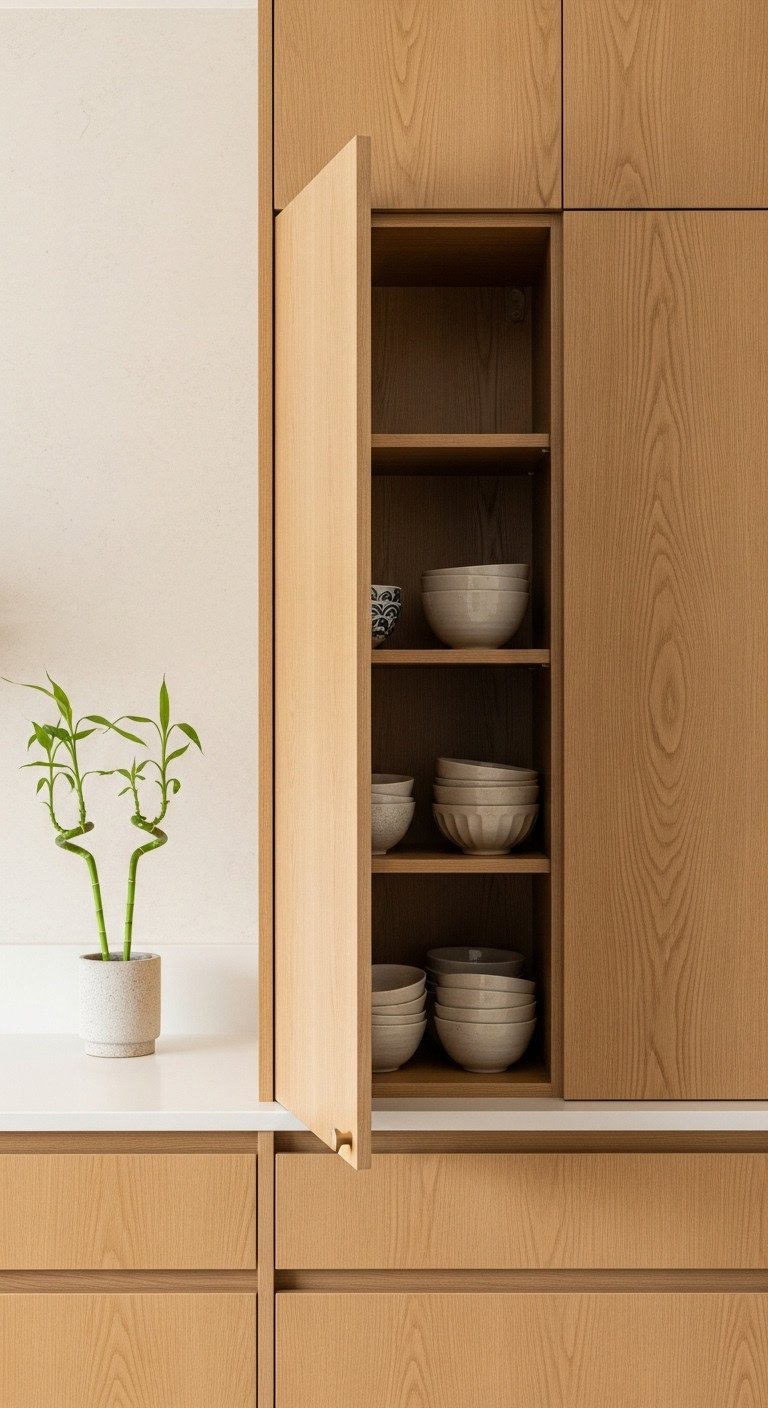
Save this idea to your ‘Minimalist Kitchen’ board!
The core of the Japanese kitchen is achieving a clean, uncluttered look by strategically hiding everyday essentials. This creates visual silence, allowing the mind to relax. The goal is to make countertops as clear as possible, giving you a sense of freedom and space. This is accomplished through smart, integrated storage that values function over ornamentation.
- Materials Needed:
- Flat-panel cabinet doors
- Push-to-open latch hardware
- Drawer dividers
- Integrated appliance panels
- Step-by-Step Directions:
- Start by choosing flat-panel cabinet doors. Their completely flat surface is essential for creating the seamless, unbroken look that defines this style. Avoid any trim, beveling, or decorative details.
- The true secret to the minimalist aesthetic is installing high-quality push-to-open and soft-close hardware on all your cabinets and drawers. This completely eliminates the need for visible handles or knobs, which can act as visual clutter.
- True organization happens inside. Use smart drawer dividers, pull-out pantry systems, and other internal organizers to ensure everything has a dedicated place and is easily accessible, but remains completely out of sight.
- For the ultimate seamless look, consider using appliance panels that perfectly match your cabinetry. These custom panels fit over the front of your dishwasher and refrigerator, making them disappear into the wall of cabinets.
Pro-Tip: Before committing to a full set of push-to-open hardware, order a single sample to test. The tactile feel of the mechanism is crucial for a luxury experience. A cheap, flimsy latch can feel unsatisfying and ruin the high-end, thoughtful effect you’re aiming for.
2. Prioritize Natural Materials Like Wood and Stone
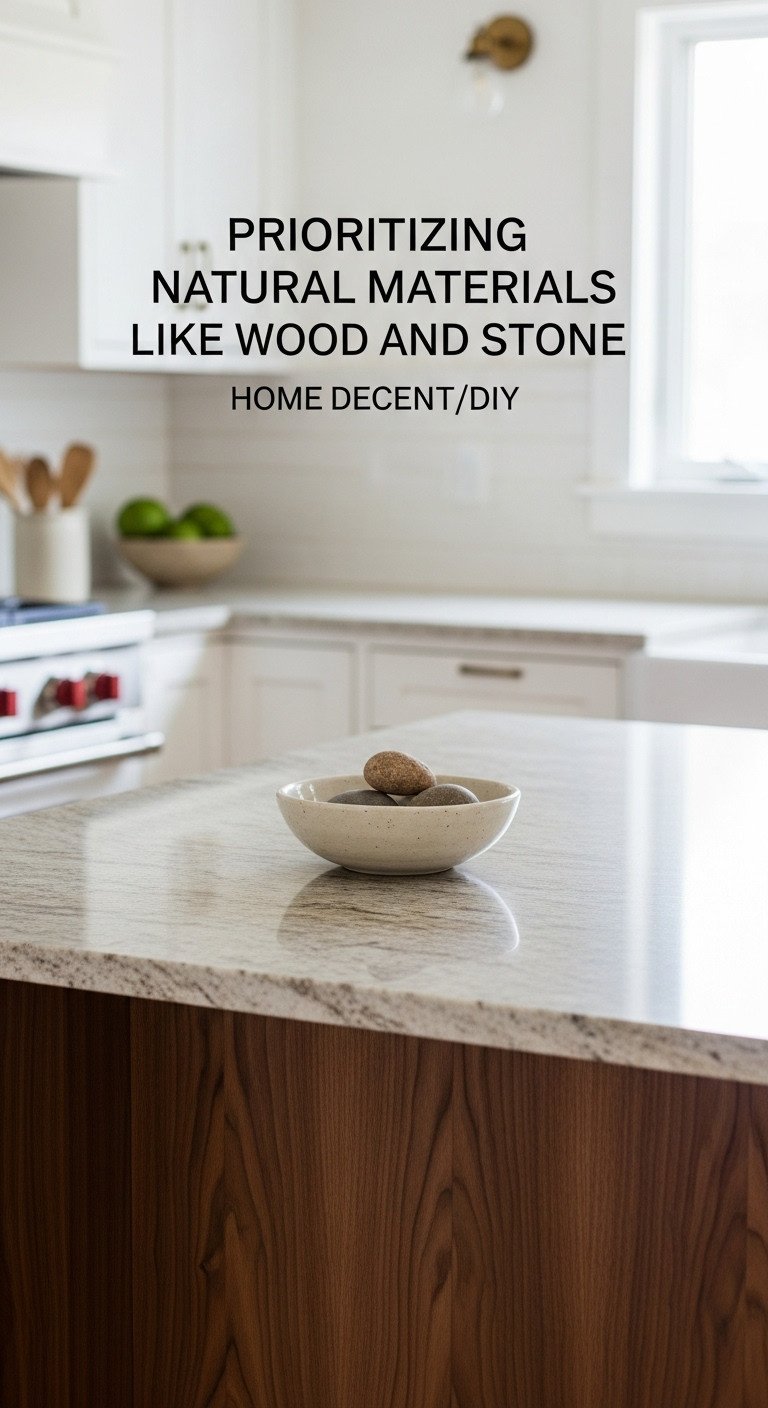
Save this to your ‘Natural Home’ inspiration board!
To create an authentic Japanese kitchen feel, you must choose natural materials that bring warmth, texture, and a connection to the outdoors. This philosophy emphasizes materials that are honest and show their inherent character. Wood, stone, and bamboo are the foundational elements that ground the space and provide a sense of enduring quality and calm.
- Materials Needed:
- Natural wood veneer or solid wood for cabinets
- Natural stone slab for countertops
- Bamboo drawer organizers or decor
- Handmade ceramics
- Step-by-Step Directions:
- Select a primary wood that will define the character of your kitchen. Light woods like oak or maple create an airy, bright feel perfect for the Japandi style. For a richer, warmer atmosphere, consider darker woods like American walnut.
- For countertops, choose a durable, natural stone such as honed granite or slate. Opt for a matte or honed finish over a high-gloss polish to emphasize the stone’s natural texture and subtle imperfections.
- Weave in smaller bamboo elements to add layers of authenticity. This can be as simple as a bamboo cutting board on display, utensil holders, or even flooring. A fantastic and functional starting point is to use high-quality expandable bamboo drawer dividers to bring that natural feel inside your cabinets.
- Finally, display a few curated pieces of handmade ceramics. A small collection of mugs, bowls, or a teapot on an open shelf adds a touch of artistry and celebrates the human hand in a way that mass-produced items cannot.
Lesson Learned: Sealing is absolutely non-negotiable for natural wood and stone countertops to protect them from the rigors of kitchen life. I highly recommend using a high-quality, food-safe matte sealant. This will protect the material from stains and water damage without adding an artificial-looking gloss, preserving the raw, natural beauty you chose it for.
3. Use a Muted and Earthy Color Palette
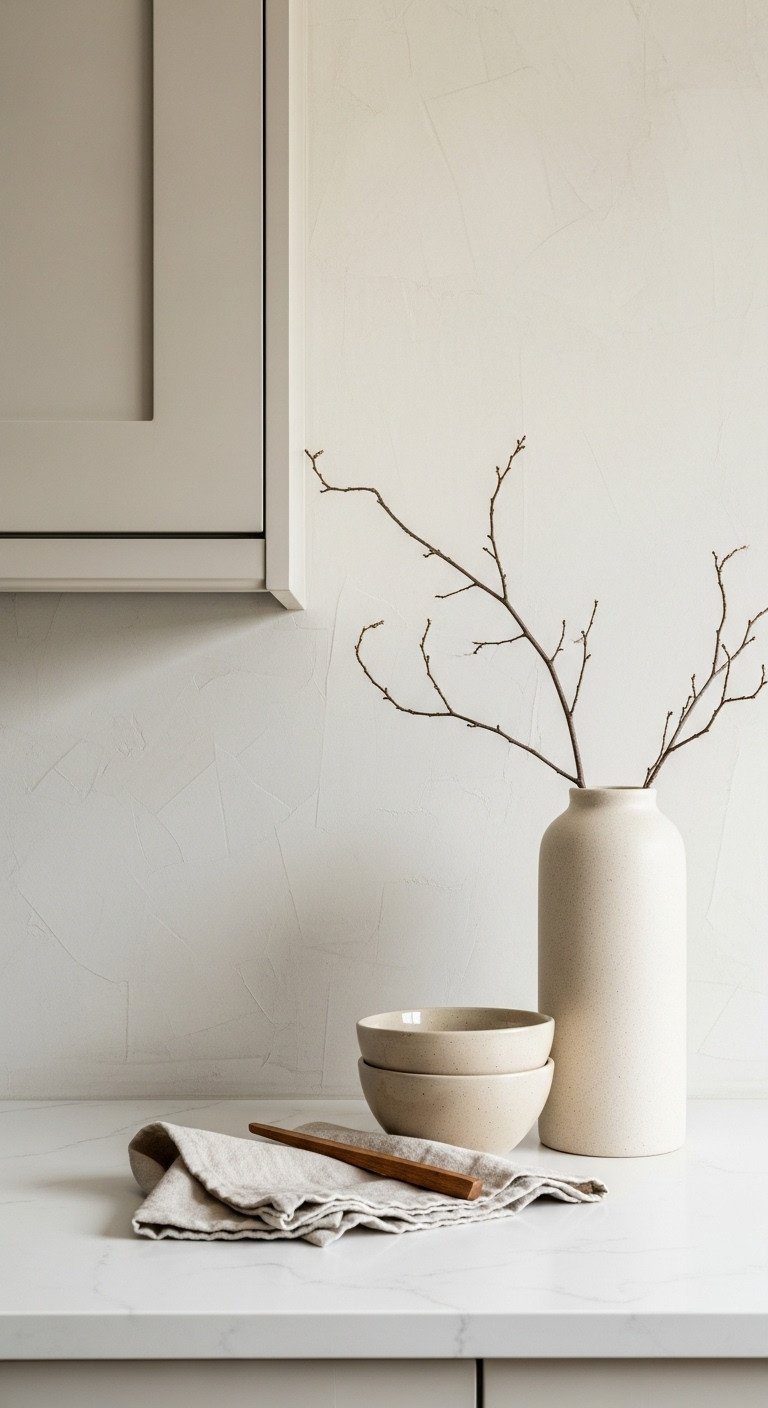
Love this calm color scheme? Save it to your ‘Home Palette’ board!
The right color combinations are essential for creating a serene and calming kitchen atmosphere by using muted, warm, and earthy tones. This palette is drawn directly from nature—think sand, stone, wood, and clay. These colors are not meant to shout for attention; they are meant to create a quiet, harmonious backdrop that allows the natural materials in the room to shine.
- Materials Needed:
- High-quality interior paint in your chosen neutral shades (e.g., beige, cream, sand)
- Paint rollers and brushes
- Specialty paint, such as limewash (optional)
- Step-by-Step Directions:
- Begin by choosing a primary warm neutral for your walls. Colors like soft beige, warm sand, or a creamy off-white are excellent choices because they reflect natural light beautifully and create an instant sense of calm.
- If you want to add texture and depth for a more Wabi-Sabi feel, consider using a specialty paint. A limewash paint, for example, gives walls a soft, chalky, and beautifully imperfect finish that adds immense character.
- Ensure your cabinetry complements this palette. Keep cabinets in a similar light neutral tone or let their natural wood finish provide the warmth.
- Use dark colors like black or charcoal very sparingly, treating them as powerful accents. A matte black faucet, a dark stone countertop, or a single black-framed piece of art can create a stunning focal point that grounds the space without overwhelming its tranquility.
Pro-Tip: I cannot stress this enough: always test your paint samples directly on your wall and observe them in different lighting conditions throughout the day—morning, noon, and evening. A color that looks like the perfect beige in the brightly lit store can unexpectedly appear yellow, gray, or even pink in your home’s unique natural and artificial light.
4. Foster a Connection to Nature
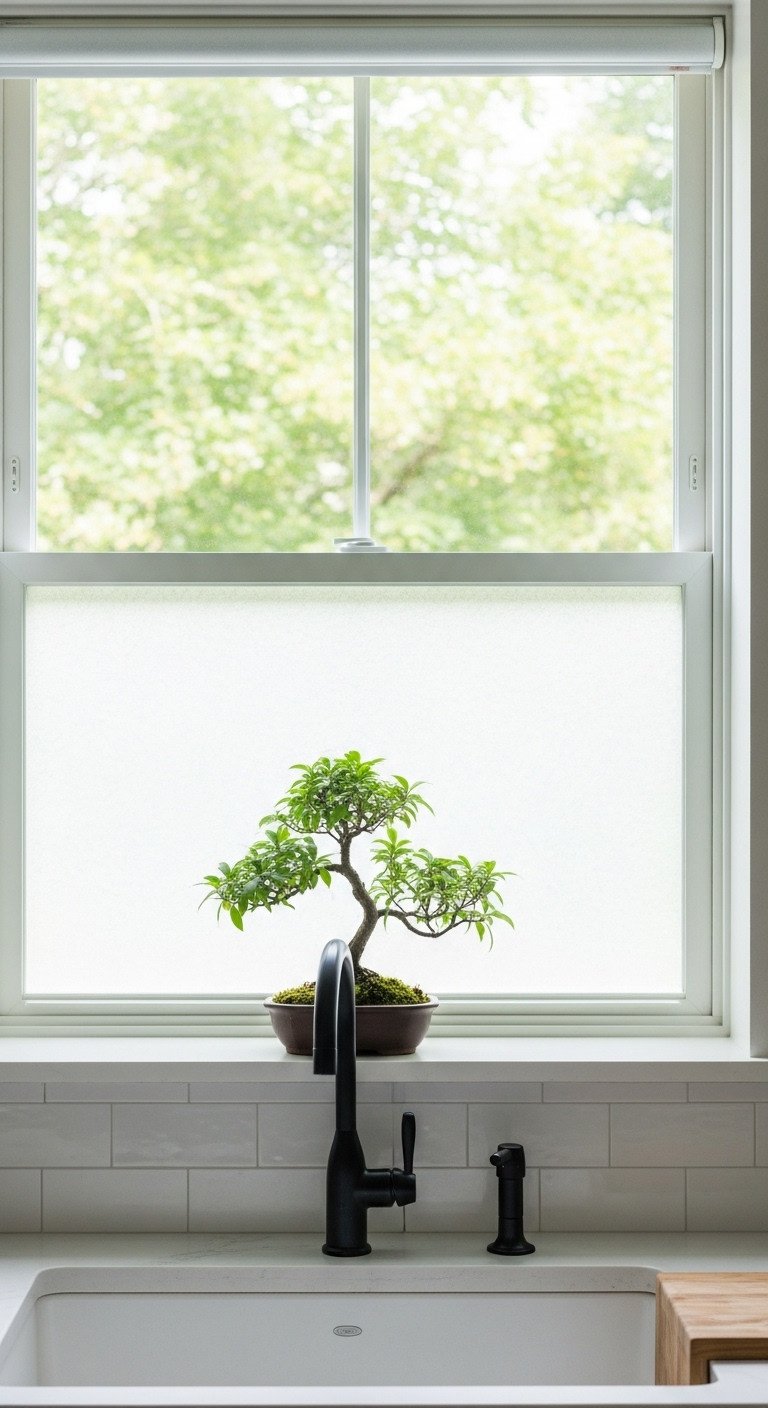
Save this beautiful window idea to your ‘Zen Home’ board!
A key characteristic of Japanese design is blurring the boundaries between the interior and the natural world, bringing more natural light and a sense of the outdoors into your kitchen. This can be achieved through large windows, translucent materials, and the mindful placement of plants. The goal is to make the space feel open, airy, and deeply connected to the rhythms of nature.
- Materials Needed:
- Translucent window film (rice paper style)
- Light linen curtains or bamboo blinds
- Small potted plants (e.g., bonsai, herbs, a single orchid)
- Step-by-Step Directions:
- Your first priority should be to maximize natural light. Keep window treatments minimal and light. Simple, airy linen curtains that can be drawn fully aside or simple bamboo blinds are far better choices than heavy, ornate drapes.
- To gain privacy without sacrificing precious daylight, apply a frosted or rice paper style window film directly to your window glass. This is a brilliant and affordable way to mimic the soft, beautifully diffused light of traditional Japanese Shoji screens.
- Introduce greenery with clear intention and purpose. In Japanese design, a single, elegant bonsai tree on a windowsill or a simple ikebana flower arrangement is considered more impactful and beautiful than a cluttered collection of many different plants.
- If your kitchen has a view of a garden or even a single tree, keep that view as unobstructed as possible. This visual connection helps to dissolve the barrier between inside and out, enhancing the room’s tranquility.
Pro-Tip: Explore the art of Ikebana, which is the Japanese art of flower arranging. It’s a wonderful practice that focuses on structure, space, and minimalism. You’ll quickly learn that you don’t need a huge, expensive bouquet to make a statement; sometimes, a single, interesting branch found on a walk and placed in a beautiful vase is all you need to create a moment of profound beauty.
5. Illuminate with Soft, Ambient Lighting
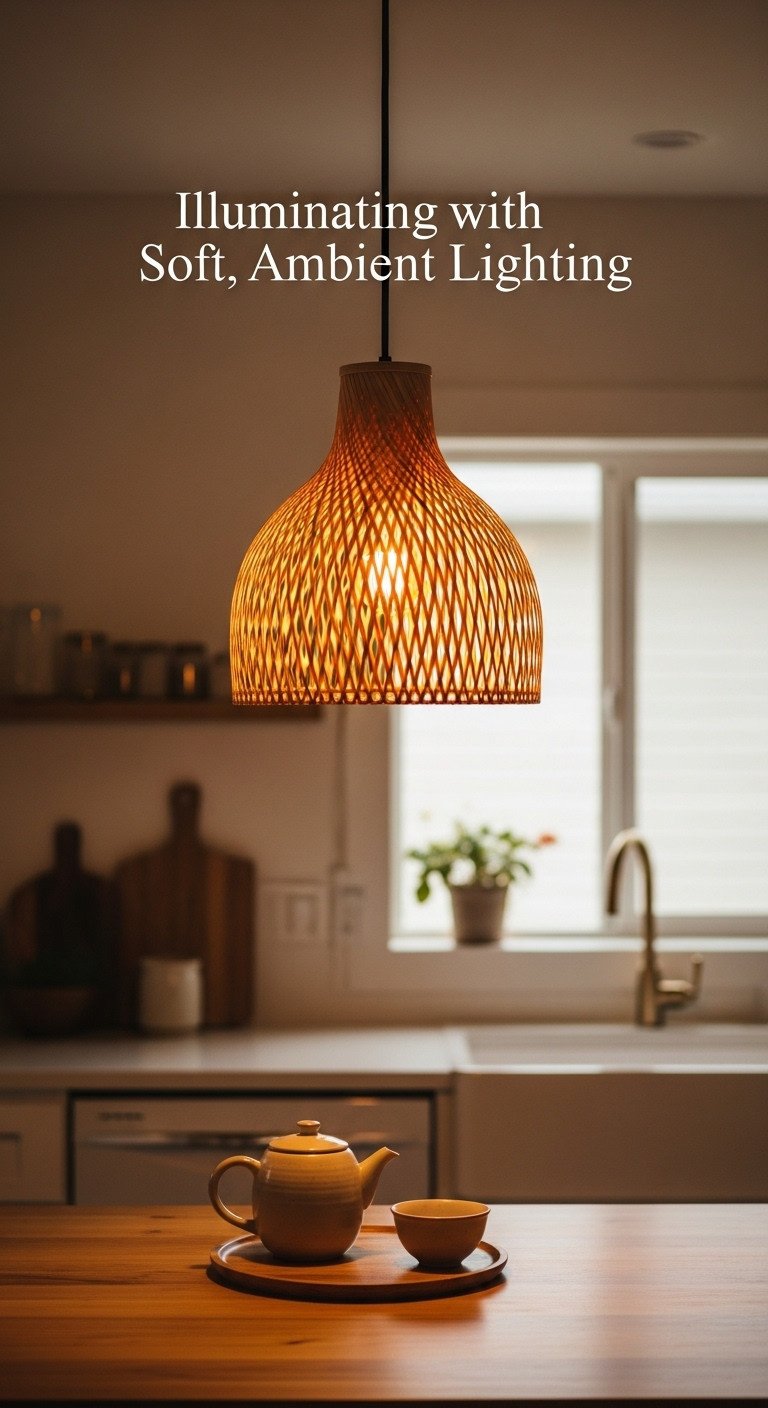
Add this cozy lighting idea to your ‘Dream Kitchen’ board!
Lighting in a Japanese kitchen is not just functional; it’s a crucial element for creating a warm, inviting, and specific mood. The goal is to use soft, warm, and diffused light to highlight the natural textures of your materials and create a cozy, serene feeling, especially in the evening. This is achieved by layering different types of light sources.
- Materials Needed:
- Pendant light with a natural shade (e.g., washi paper, bamboo, wood)
- Dimmable under-cabinet LED light strips (warm white)
- Dimmer switches
- Step-by-Step Directions:
- The key to great lighting is to layer it. You need bright, functional task lighting for chopping and cooking, but also soft, ambient mood lighting for relaxing and dining.
- For your main source of ambient light, choose a statement pendant light crafted from natural materials. A fixture made of washi paper, thin wood veneer, or woven bamboo hanging over an island or dining area will serve as a beautiful focal point and cast a gentle, warm glow.
- Next, install dimmable, warm-white under-cabinet LED light strips. These are absolutely essential for providing clear, shadow-free task lighting directly onto your countertops. In the evening, they can be dimmed to a soft glow, adding depth to the room.
- To give you complete control over the atmosphere of your kitchen, install dimmer switches on all your main lights. This simple addition allows you to transition the room’s mood from bright and functional to low and intimate with ease.
Pro-Tip: Pay close attention to the color temperature of your light bulbs, which is measured in Kelvins (K). For that cozy, candle-like glow, look for bulbs labeled “warm white” or with a Kelvin rating of around 2700K to 3000K. Avoid anything higher, as it will produce a harsh, clinical blue-white light that feels sterile and counterproductive to a calm atmosphere.
6. Decorate with Purposeful Restraint
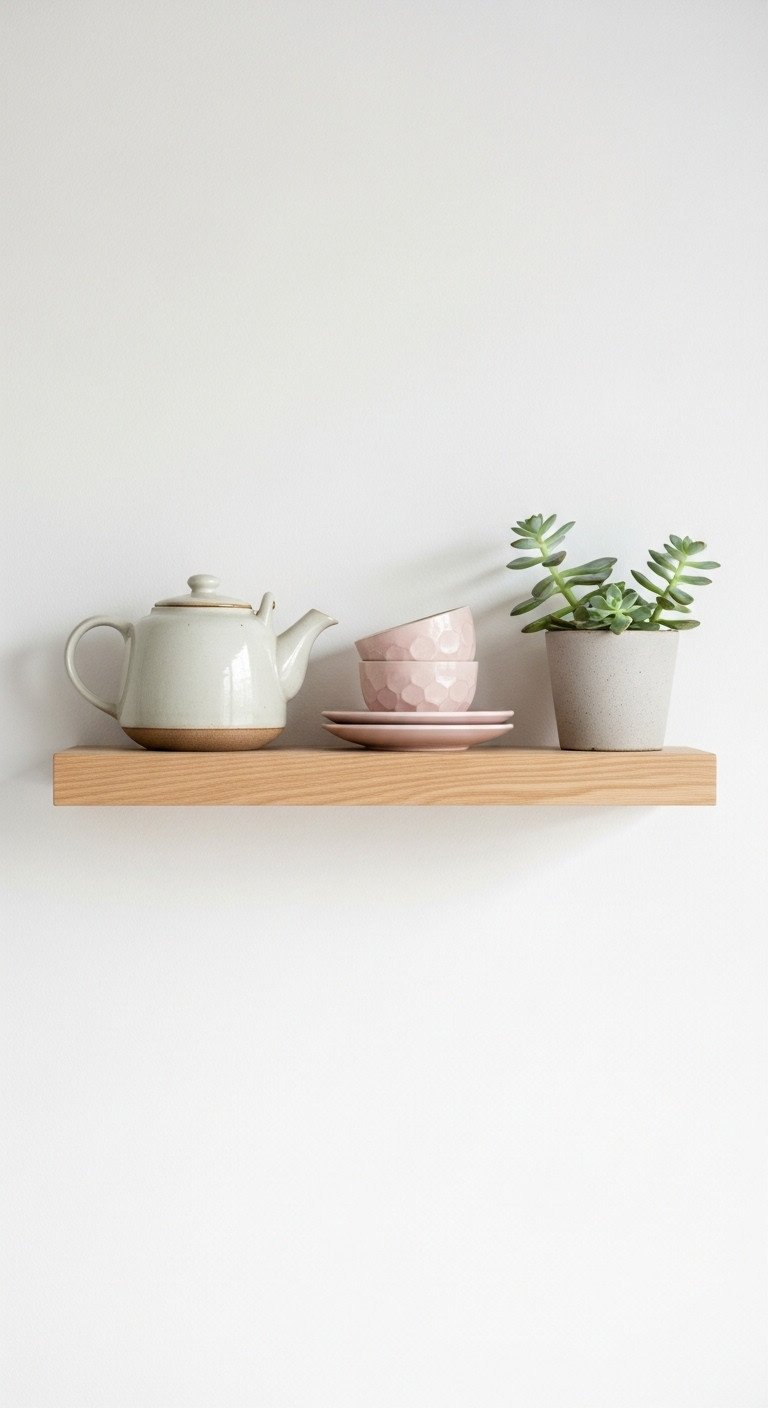
Save this minimalist shelfie idea to your ‘Decor Inspo’ board!
The “less is more” approach is paramount when decorating a Japanese-style kitchen by choosing only a few beautiful, functional, and meaningful items. Every single object on display should earn its place. The goal is not to fill empty space, but to celebrate it, allowing each carefully selected piece to be appreciated without competition from clutter.
- Materials Needed:
- Floating shelves with hidden brackets
- A few curated decorative objects (e.g., handmade vases, a beautiful teapot, a small sculpture)
- A piece of simple wall art
- Linen tea towels
- Step-by-Step Directions:
- Adopt a “one in, one out” rule to actively prevent the accumulation of clutter. Every decorative item should either serve a practical purpose or hold significant personal meaning for you.
- Use open shelving very sparingly. If you choose to have a floating shelf, treat it like a gallery display for your most beautiful and functional items—think of a stunning cast-iron teapot or a few handmade ceramic bowls. To maintain the clean aesthetic, you’ll need sturdy floating shelf brackets that are completely hidden from view.
- When it comes to wall art, one or two simple pieces are far more impactful than a busy gallery wall. A minimalist ink wash painting, a piece of Japanese calligraphy, or a simple nature photograph is perfect.
- Incorporate natural textiles to add softness and texture. A set of high-quality linen tea towels neatly folded or a simple cotton table runner can add a subtle hint of color and a layer of comfort.
Lesson Learned: It is always better to have one empty shelf than one cluttered shelf. In Japanese design, empty space is called ‘ma’, and it’s not considered a void to be filled. Instead, it is treated as an active and essential element that promotes a feeling of calm, possibility, and openness.
7. Celebrate Craftsmanship and Imperfection (Wabi-Sabi)
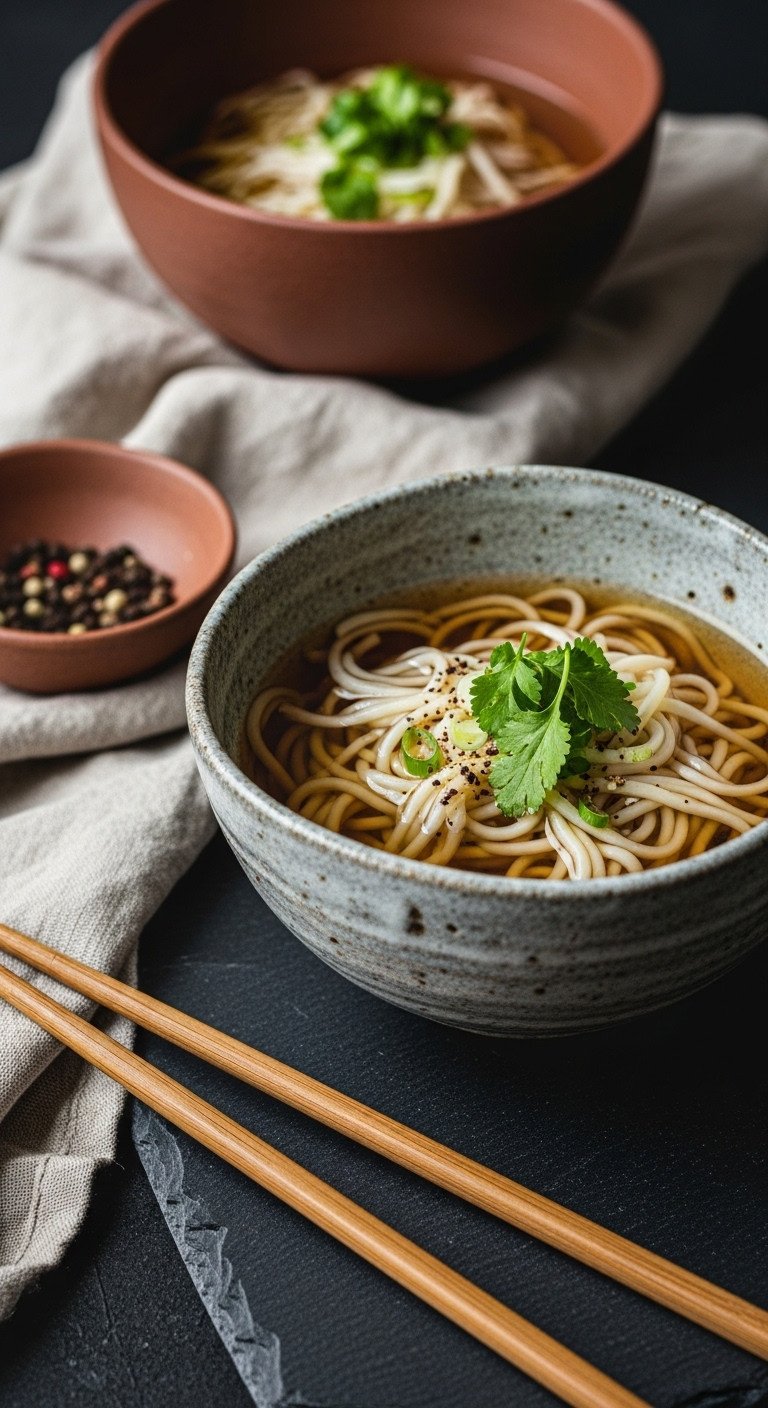
Embrace imperfection! Save this Wabi-Sabi inspiration to your board.
The Wabi-Sabi philosophy is about finding profound beauty in imperfection, and you can incorporate it by choosing handmade, authentic items that show their age and character. This is the soulful counterpoint to pure minimalism. It’s about celebrating the history of objects and the touch of the human hand, which adds a deep layer of warmth and personality to your kitchen.
- Materials Needed:
- Handmade ceramic or glass items (bowls, mugs, plates)
- Natural fiber textiles (linen, raw cotton)
- Solid wood cutting boards
- Step-by-Step Directions:
- Make a conscious choice to invest in everyday items that are well-made and will age gracefully. Think of a solid wood cutting board that will develop knife marks, stains, and character over years of use, telling the story of countless meals.
- Whenever possible, seek out handmade items instead of mass-produced, perfectly uniform ones. Look for a set of beautiful handmade ceramic ramen bowls where the glaze on each piece is slightly different, giving each one its own unique personality.
- Don’t be afraid of materials that show wear and tear. A stone countertop with faint marks from a hot pan or a wooden table with a developing patina tells a story and adds an irreplaceable warmth to the space.
- Choose textiles like pure linen or raw cotton for your dish towels and napkins. These natural fibers soften, fade, and become more beautiful and comfortable with each and every wash.
Pro-Tip: It’s important to remember that Wabi-Sabi is not an excuse for messiness or neglect. It’s a highly mindful practice of choosing items whose natural imperfections add character and soul to an otherwise clean, organized, and intentional space.
Key Takeaways: Your Quick Guide to a Traditional Japanese Kitchen
Feeling overwhelmed? Don’t be. Creating a kitchen with a traditional Japanese feel is about embracing a few core principles. If you remember nothing else, focus on these five key takeaways to guide your transformation.
- Less is More: The foundation of a calm kitchen is ruthless decluttering. Prioritize hidden, integrated storage to keep surfaces clear and create a spacious, open feel.
- Nature is Key: Ground your design in the natural world. Use authentic materials like wood for cabinets, stone for countertops, and bamboo for accents.
- Calm Colors: Stick to a muted, earthy color palette. Think of warm neutrals like sand, beige, cream, and soft whites to create a serene backdrop.
- Soft Light: Your lighting is a mood-setter. Layer soft, warm, and diffused lighting sources, such as paper pendant lamps and dimmable under-cabinet lights, to create a cozy atmosphere.
- Mindful Decor: Every object on display should be either beautiful or useful—preferably both. Choose fewer, more meaningful items and celebrate the beauty of empty space.
People Also Ask About Traditional Japanese Kitchens
When exploring this beautiful design philosophy, a few common questions often come up. Here are the clear, concise answers to help guide your journey.
What is a traditional Japanese kitchen called?
A traditional Japanese kitchen is formally called a “Daidokoro” (台所). Historically, the heart of the kitchen was also referred to as the “Kamado” (かまど), which specifically means stove, as this was considered the symbolic soul of the home. Modern designs still honor this principle of the kitchen being a central, vital space.
What is a Japanese style kitchen?
A Japanese style kitchen is a design aesthetic focused on achieving harmony through minimalism, functionality, and a deep connection to nature. It is characterized by the use of natural materials like wood and stone, a muted and earthy color palette, clean and uncluttered surfaces, and highly efficient storage solutions to create a serene and balanced environment.
How do I incorporate Wabi-Sabi into my kitchen?
You can incorporate Wabi-Sabi into your kitchen by mindfully embracing the beauty of imperfection and natural materials. This means choosing handmade ceramic dishes over perfectly uniform sets, using a wooden cutting board that proudly shows its age and use, and decorating with simple, natural elements like a single branch in a vase. It is the art of finding beauty in things that are authentic, modest, and imperfect.
Final Thoughts
Creating a traditional Japanese kitchen is ultimately less about following a rigid set of rules and more about adopting a mindful philosophy. It is a rewarding journey toward creating a space that not only serves its practical function with incredible efficiency but also provides you with a daily sanctuary of peace and tranquility. It transforms chores into rituals and a room into a retreat.
As you look at your own space, remember that even small changes can make a big difference. You don’t need a complete renovation to start embracing these principles. What is the first step you’ll take to bring a little more calm and intention into your kitchen?
Last update on 2025-10-15 at 11:19 / Affiliate links / Images from Amazon Product Advertising API
